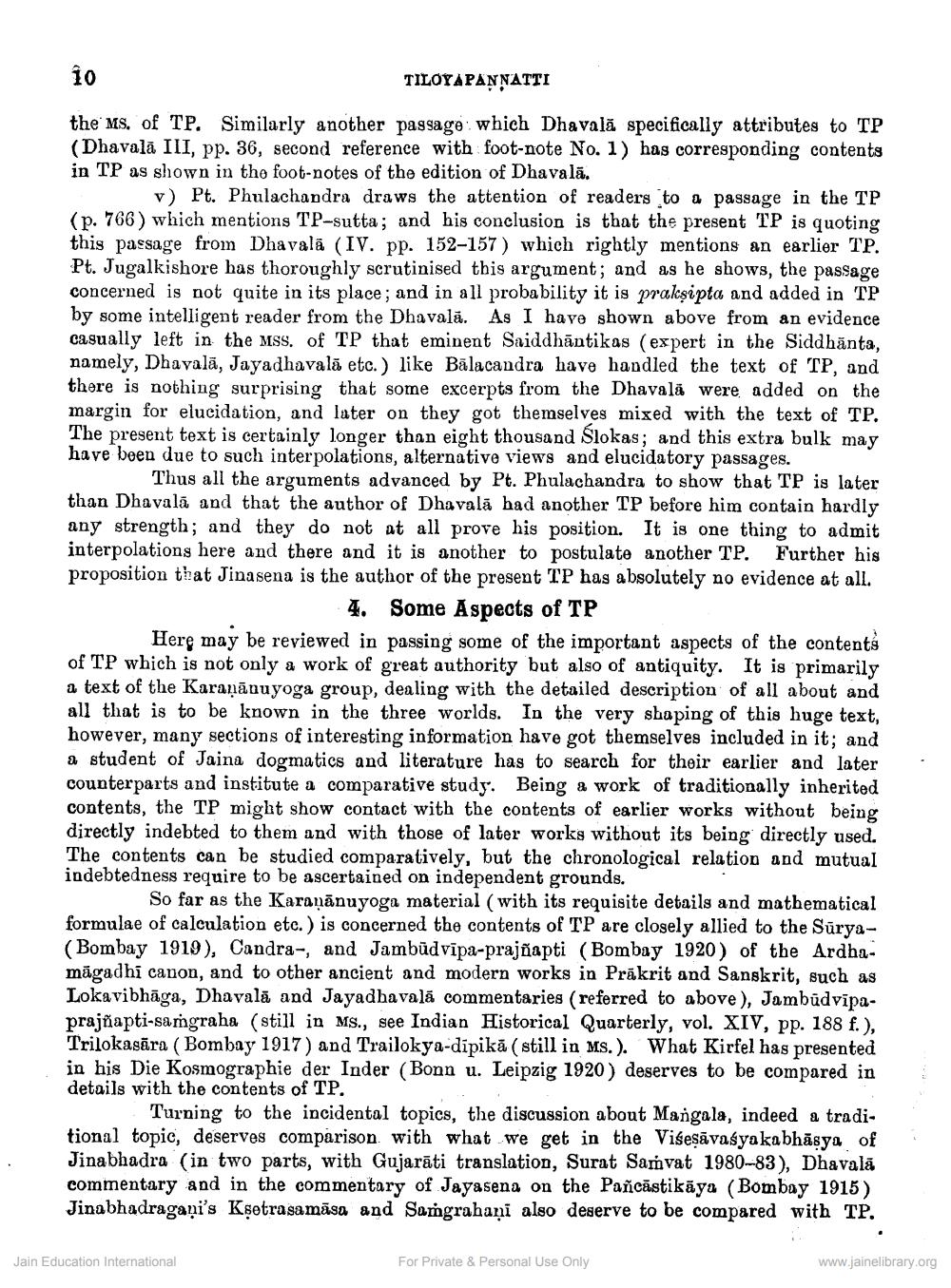________________
TILOYAPANNATTI
the Ms. of TP. Similarly another passage which Dhavală specifically attributes to TP (Dhavalā III, pp. 36, second reference with foot-note No. 1) has corresponding contents in TP as shown in the foot-notes of the edition of Dhavalā.
v) Pt. Phulachandra draws the attention of readers to a passage in the TP (p. 766) which mentions TP-sutta; and his conclusion is that the present TP is quoting this passage from Dhavalá (IV. pp. 152-157) which rightly mentions an earlier TP. Pt. Jugalkishore has thoroughly scrutinised this argument; and as he shows, the passage concerned is not quite in its place; and in all probability it is prakṣipta and added in TP by some intelligent reader from the Dhavală. As I have shown above from an evidence casually left in the Mss. of TP that eminent Saiddhāntikas (expert in the Siddhānta, namely, Dhavalā, Jayadhavală etc.) like Bālacandra have handled the text of TP, and there is nothing surprising that some excerpts from the Dhavalá were added on the margin for elucidation, and later on they got themselves mixed with the text of TP. The present text is certainly longer than eight thousand Slokas; and this extra bulk may have been due to such interpolations, alternative views and elucidatory passages.
Thus all the arguments advanced by Pt. Phulachandra to show that TP is later than Dhavalā and that the author of Dhavalı had another TP before him contain hardly any strength; and they do not at all prove his position. It is one thing to admit interpolations here and there and it is another to postulate another TP. Further his proposition that Jinasena is the author of the present TP has absolutely no evidence at all.
4. Some Aspects of TP Here may be reviewed in passing some of the important aspects of the contents of TP which is not only a work of great authority but also of antiquity. It is primarily a text of the Karaņānuyoga group, dealing with the detailed description of all about and all that is to be known in the three worlds. In the very shaping of this huge text, however, many sections of interesting information have got themselves included in it; and a student of Jaina dogmatics and literature has to search for their earlier and later counterparts and institute a comparative study. Being & work of traditionally inherited contents, the TP might show contact with the contents of earlier works without being directly indebted to them and with those of later works without its being directly used. The contents can be studied comparatively, but the chronological relation and mutual indebtedness require to be ascertained on independent grounds.
So far as the Karaņānuyoga material (with its requisite details and mathematical formulae of calculation etc.) is concerned the contents of TP are closely allied to the Sūrya(Bombay 1919), Candra-, and Jambūdvīpa-prajñapti (Bombay 1920) of the Ardhamāgadhi canon, and to other ancient and modern works in Prākrit and Sanskrit, such as Lokavibhāga, Dhavala and Jayadhavală commentaries (referred to above), Jambūdvipaprajšapti-samgraha (still in Ms., see Indian Historical Quarterly, vol. XIV, pp. 188 f.), Trilokasāra ( Bombay 1917) and Trailokya-dipikā (still in Ms.). What Kirfel has presented in his Die Kosmographie der Inder (Bonn u. Leipzig 1920) deserves to be compared in details with the contents of TP.
Turning to the incidental topics, the discussion about Mangala, indeed a traditional topic, deserves comparison with what we get in the Viseşāvaśyakabhāsya of Jinabhadra (in two parts, with Gujarāti translation, Surat Samvat 1980-83), Dhavalı commentary and in the commentary of Jayasena on the Pañcāstikāya (Bombay 1915) Jinabhadragani's Ksetrasamāsa and Sangrahaņi also deserve to be compared with TP.
Jain Education International
For Private & Personal Use Only
www.jainelibrary.org




